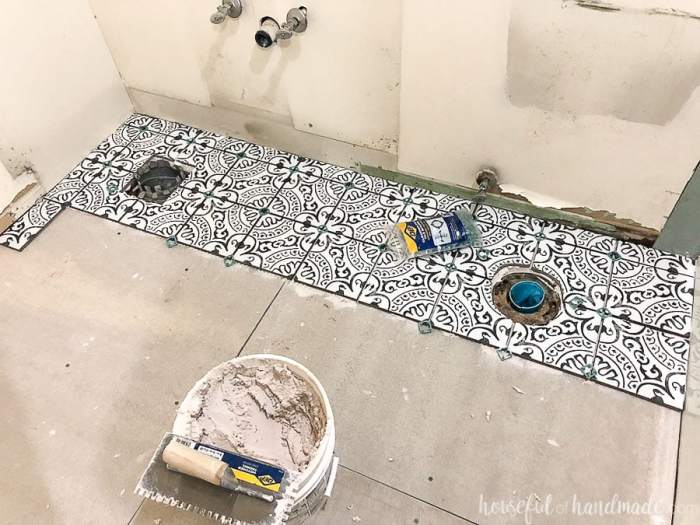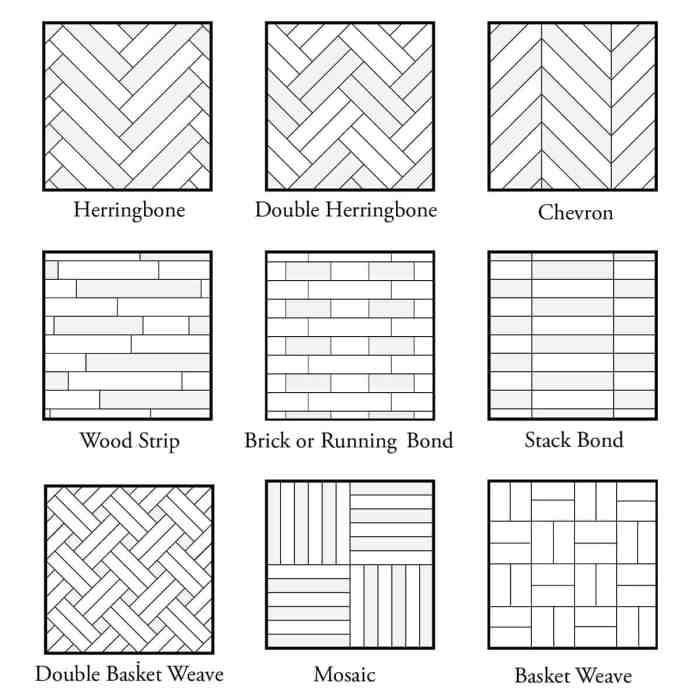In the realm of bathroom design, the floor plays a pivotal role in shaping the overall ambiance and style. Creative tile laying patterns offer a unique opportunity to transform a functional space into a visually captivating haven. This comprehensive guide will delve into the world of bathroom floor tile design, exploring various patterns, materials, and techniques to help you create a bathroom that is both aesthetically pleasing and practical.
From geometric mosaics to organic herringbone patterns, the possibilities for creative tile laying are endless. This guide will provide you with the inspiration and knowledge you need to design a bathroom floor that reflects your personal style and creates a space that you’ll love for years to come.
Patterns and Designs
When selecting tile laying patterns for bathroom floors, consider the overall style and ambiance you wish to create. Geometric patterns, such as hexagons, squares, and triangles, add a modern and sophisticated touch. Mosaic patterns, composed of small, colorful tiles, create a vibrant and playful atmosphere.
Organic designs, inspired by nature, bring a sense of tranquility and warmth to the space.
Geometric Patterns
Geometric patterns are characterized by clean lines and sharp angles. They create a sense of order and precision, making them a popular choice for contemporary bathrooms. Hexagonal tiles, arranged in a honeycomb pattern, add a touch of elegance and interest.
Square tiles, laid in a grid or herringbone pattern, create a classic and timeless look. Triangular tiles, arranged in a chevron or geometric mosaic, add a dynamic and modern element.
Mosaic Patterns
Mosaic patterns are composed of small, often colorful tiles arranged in intricate designs. They create a vibrant and playful atmosphere, making them ideal for bathrooms with a bohemian or eclectic style. Mosaic tiles can be used to create a variety of patterns, from traditional Moroccan designs to modern geometric mosaics.
The use of different colors and materials, such as glass, ceramic, or stone, adds depth and texture to the floor.
Organic Patterns
Organic patterns are inspired by natural forms, such as flowers, leaves, and water. They create a sense of tranquility and warmth, making them a popular choice for bathrooms with a spa-like or nature-inspired ambiance. Organic patterns can be created using tiles in natural colors, such as beige, brown, and green.
They can also be used to create a flowing, mosaic-like design, reminiscent of a babbling brook or a blooming flower.
Materials and Finishes
When selecting tiles for your bathroom floor, you’ll encounter a wide range of materials and finishes. Understanding the properties and aesthetic qualities of each will help you make an informed decision that aligns with your functional and design preferences.
Ceramic Tiles
- Durable and water-resistant, making them a popular choice for bathroom floors.
- Available in a variety of colors, patterns, and textures.
- Require regular sealing to maintain water resistance.
Porcelain Tiles
- More durable and water-resistant than ceramic tiles.
- Can mimic the appearance of natural stone at a lower cost.
- Can be more expensive than ceramic tiles.
Natural Stone Tiles
- Luxurious and durable, but also more expensive.
- Require regular sealing to protect against stains and water damage.
- Available in a wide range of colors and patterns, including marble, granite, and limestone.
Tile Finishes
Tile finishes can significantly alter the visual appeal of your floor.
Matte Finish
- Non-reflective and conceals imperfections.
- Provides a classic and understated look.
- Can be more difficult to clean than glossy finishes.
Glossy Finish
- Highly reflective and adds shine to the floor.
- Makes the space appear larger and brighter.
- Can show water spots and dirt more easily.
Textured Finish
- Provides a non-slip surface, ideal for bathrooms with slippery floors.
- Can add visual interest and depth to the floor.
- Can be more difficult to clean than smooth finishes.
Layout Techniques
Tile layout techniques play a crucial role in determining the overall aesthetics and functionality of your bathroom floor. Understanding the different techniques and their advantages and disadvantages will help you make an informed decision that aligns with your design preferences and bathroom shape.
The three most common layout techniques are straight-set, diagonal, and herringbone patterns. Each technique offers a unique visual appeal and has its own set of considerations.
Straight-Set Pattern
The straight-set pattern, also known as the brick pattern, involves laying tiles in straight rows, parallel to the walls. This classic and versatile layout is easy to install and suitable for bathrooms of all shapes and sizes. It creates a clean and uncluttered look, allowing the tile’s color and texture to take center stage.
Diagonal Pattern
The diagonal pattern involves laying tiles diagonally, creating a dynamic and visually striking effect. This layout can make a small bathroom appear larger and add interest to a rectangular or square space. However, it requires more careful planning and cutting, which can increase installation time and cost.
Herringbone Pattern
The herringbone pattern, inspired by the interlocking pattern found in fish bones, involves laying tiles in a zig-zag formation. This elegant and sophisticated layout creates a sense of movement and texture, making it a popular choice for modern and traditional bathrooms alike.
However, it is the most challenging layout to install and requires a skilled tiler.
Color and Grout
Color and grout play crucial roles in shaping the overall aesthetics and functionality of bathroom floor tile designs. Understanding their impact and selecting them wisely can enhance the visual appeal and durability of the space.
Color Schemes
Color schemes for bathroom floor tiles can vary widely, from classic neutrals to bold and vibrant hues. Neutral colors like white, beige, and gray create a timeless and versatile foundation that complements various bathroom styles. Bold colors like blues, greens, and reds add a touch of drama and personality to the space.
Impact of Color
The color of the tiles significantly influences the mood and ambiance of the bathroom. Light colors, such as white and beige, create a sense of spaciousness and brightness, making them ideal for smaller bathrooms. Darker colors, like black and navy, exude a luxurious and sophisticated feel, but they may require more lighting to avoid making the space feel cramped.
Grout Options
Grout, the material that fills the spaces between tiles, offers both aesthetic and practical benefits. It can complement or contrast with the tiles, depending on its color, texture, and width.
Color
Grout color can enhance or detract from the overall design. Neutral colors like white or gray blend seamlessly with most tiles, creating a cohesive look. Contrasting grout colors, such as black or dark gray, can highlight the tile pattern and add visual interest.
Texture
Grout texture can add depth and character to the floor. Smooth grout creates a clean and polished appearance, while textured grout adds a rustic or industrial touch. Textured grout can also be more resistant to staining and dirt.
Width
Grout width affects the overall look of the floor. Narrow grout lines create a more modern and streamlined appearance, while wider grout lines can add a touch of vintage charm or rusticity. Wider grout lines can also be more forgiving of imperfections in the tile installation.
Durability and Aesthetics
Selecting grout that complements the tiles both aesthetically and functionally is crucial. Grout should be resistant to moisture, stains, and wear to ensure longevity. Choosing a grout color that complements the tiles can enhance the overall design, while a contrasting color can create a more dynamic look.
Unique and Creative Ideas
Break away from conventional tile laying patterns and embrace innovative designs. Incorporate unique elements like accent tiles, borders, and inlays to create a visually captivating and personalized bathroom floor. Explore the use of mixed materials and textures to add depth and intrigue to your floor design.
Accent Tiles
Introduce visual interest by using accent tiles that contrast in color, pattern, or texture. Arrange them in a focal point or as a border to define specific areas of the bathroom.
Borders and Inlays
Create a sophisticated look with borders and inlays. Borders can frame the entire floor or accentuate specific sections, while inlays can add intricate details and patterns.
Mixed Materials and Textures
Combine different tile materials, such as ceramic, porcelain, or natural stone, to create a unique and textured floor. Vary the surface finishes, such as matte, glossy, or textured, to add depth and visual appeal.
Inspiration and Examples
Let your creativity soar as you delve into a gallery of inspiring bathroom floor tile designs. Explore the endless possibilities of patterns, materials, and colors to envision the perfect transformation for your bathroom.
Each image showcases the captivating impact of unique tile laying techniques and combinations, offering a visual testament to the versatility and aesthetic power of creative tilework.
A Gallery of Inspiring Designs
- Chevron Pattern: This classic pattern adds a touch of elegance with its zigzag lines, creating a sense of movement and visual interest.
- Hexagonal Tiles: These geometric tiles offer a modern and playful touch, allowing for intricate patterns and eye-catching color combinations.
- Mosaic Tiles: Small, colorful tiles create a vibrant and intricate tapestry, adding a touch of whimsy and character to the bathroom floor.
- Marble Tiles: Luxurious and timeless, marble tiles bring a sense of sophistication and grandeur, creating a spa-like atmosphere.
- Wood-Look Tiles: These tiles mimic the warmth and texture of wood, adding a cozy and inviting touch to the bathroom.
Comparison of Design Elements
| Design Element | Options |
|---|---|
| Pattern | Chevron, hexagonal, mosaic, subway, herringbone |
| Material | Ceramic, porcelain, marble, natural stone, wood-look |
| Finish | Glossy, matte, textured, honed |
| Grout | Matching, contrasting, colored |
This table illustrates the wide range of design elements available, allowing you to customize your bathroom floor tile design to perfectly match your personal style and the overall aesthetic of your bathroom.
Last Point
Whether you’re looking to create a classic and timeless look or embrace bold and contemporary designs, this guide has something for everyone. With careful planning and attention to detail, you can transform your bathroom floor into a work of art that will elevate the entire space.
So, let your creativity soar and embark on a journey to design a bathroom floor that is both functional and visually stunning.



